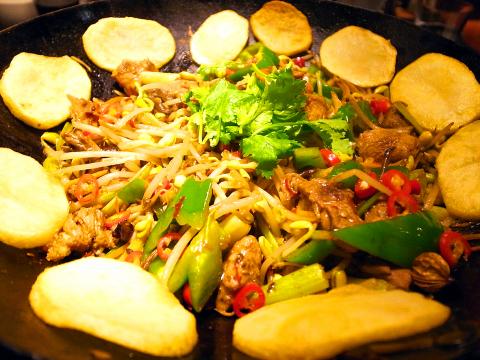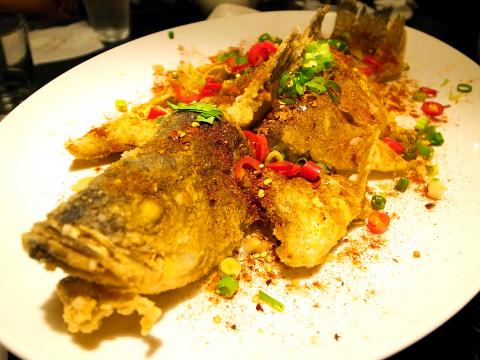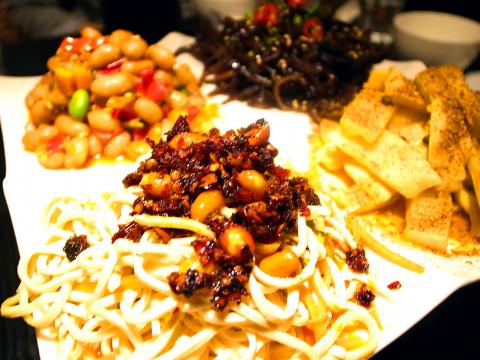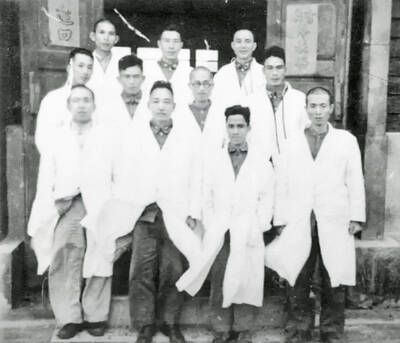Dining at Oriental Cuisine is like taking a crash course in Guizhou food, thanks to meticulous proprietor and chef David Yeh (葉國憲), who trekked to the mountainous region on the Yunnan-Guizhou Plateau in 2008 to study the locale’s style of Chinese cooking, which is celebrated for its complex spiciness and vinegary flavors.
Yeh is possibly the most diligent restaurateur I have ever encountered. On a recent visit, the neatly dressed chef not only took his time to greet our group of six and make recommendations while helming the kitchen, he also presented each dish and genially explained their origin and ingredients.
According to him, since the weather in Guizhou is often humid and chilly, the locals have long munched on a wide variety of spicy foods to stave off the cold.

Photo: Ho Yi, Taipei Times
Depending on the type of hot pepper used and how it is prepared and mixed with other spices, Guizhou cuisine has more than a dozen categories of spiciness, including sour spicy, (酸辣), oily spicy (油辣) and grilled spicy (糊辣).
For first-time diners, the assorted appetizer plate (四喜拼盤, NT$200 and NT$360) is a good starting point. Made with red chili that is first stir-fried with garlic and ginger, then tossed with peppercorns (花椒), the serving of oily spicy bamboo shoots (大紅袍油辣香筍) produces a tongue-tingling numbing sensation.
The pickled chili with peanuts (糟辣浸花生) showcases the pleasantly unique tang of fermented chili, while the vinegary black jelly fungus (醋溜黑木耳) refreshes the taste buds with its lovely tartness.

Photo: Ho Yi, Taipei Times
But don’t be fooled by the appetizers’ deceivingly simple appearance. My dining companions and I were all impressed by their nuanced flavors.
A delicacy traditionally cooked on special occasions, Miao chicken dry pot (苗寨乾鍋雞, NT$350 and NT$650) evolved from the iron pots that the region’s villagers used to cook with over fire pits.
To please local palates, Yeh’s rendition uses less oil and more vegetables — green pepper, celery, bean sprouts, slices of potato. The dish’s spiciness increases as the vegetables and chicken release their juices, which condense and thicken.

Photo: Ho Yi, Taipei Times
Sourness is another characteristic of Guizhou cuisine, and a good example is the Miao sour fish soup (苗家酸湯魚, NT$380 and NT$680). Using a light, sour broth made from fermented rice, the dish combines tomatoes and fermented chili to give sea perch an exciting kick.
Halfway through our evening spread, my dining partners and I started to plan our next visit to sample other signature dishes on the restaurant’s extensive menu. Topping our list is the sweat-inducing chicken (鎮店盜汗雞, NT$1,680), which requires eight hours of meticulous preparation to transform a clay pot filled with chicken and Chinese herbs into a piping hot pot of chicken soup, all without the addition of even a drop of water. The dish needs to be ordered at least one day in advance.
Eating at the two-story establishment is a comfortable experience. With a pleasant outdoor dining area on the balcony, the restaurant is very well kept and spacious, while the air is lightly scented with Chinese herbs and spices.
Located three minutes walk from Dazhi MRT Station (大直捷運站) exit No. 1, Oriental Cuisine is tucked away in a quiet alley adjacent to the park next to the main entrance of Shih Chien University (實踐大學).

That US assistance was a model for Taiwan’s spectacular development success was early recognized by policymakers and analysts. In a report to the US Congress for the fiscal year 1962, former President John F. Kennedy noted Taiwan’s “rapid economic growth,” was “producing a substantial net gain in living.” Kennedy had a stake in Taiwan’s achievements and the US’ official development assistance (ODA) in general: In September 1961, his entreaty to make the 1960s a “decade of development,” and an accompanying proposal for dedicated legislation to this end, had been formalized by congressional passage of the Foreign Assistance Act. Two

Despite the intense sunshine, we were hardly breaking a sweat as we cruised along the flat, dedicated bike lane, well protected from the heat by a canopy of trees. The electric assist on the bikes likely made a difference, too. Far removed from the bustle and noise of the Taichung traffic, we admired the serene rural scenery, making our way over rivers, alongside rice paddies and through pear orchards. Our route for the day covered two bike paths that connect in Fengyuan District (豐原) and are best done together. The Hou-Feng Bike Path (后豐鐵馬道) runs southward from Houli District (后里) while the

March 31 to April 6 On May 13, 1950, National Taiwan University Hospital otolaryngologist Su You-peng (蘇友鵬) was summoned to the director’s office. He thought someone had complained about him practicing the violin at night, but when he entered the room, he knew something was terribly wrong. He saw several burly men who appeared to be government secret agents, and three other resident doctors: internist Hsu Chiang (許強), dermatologist Hu Pao-chen (胡寶珍) and ophthalmologist Hu Hsin-lin (胡鑫麟). They were handcuffed, herded onto two jeeps and taken to the Secrecy Bureau (保密局) for questioning. Su was still in his doctor’s robes at

Mirror mirror on the wall, what’s the fairest Disney live-action remake of them all? Wait, mirror. Hold on a second. Maybe choosing from the likes of Alice in Wonderland (2010), Mulan (2020) and The Lion King (2019) isn’t such a good idea. Mirror, on second thought, what’s on Netflix? Even the most devoted fans would have to acknowledge that these have not been the most illustrious illustrations of Disney magic. At their best (Pete’s Dragon? Cinderella?) they breathe life into old classics that could use a little updating. At their worst, well, blue Will Smith. Given the rapacious rate of remakes in modern